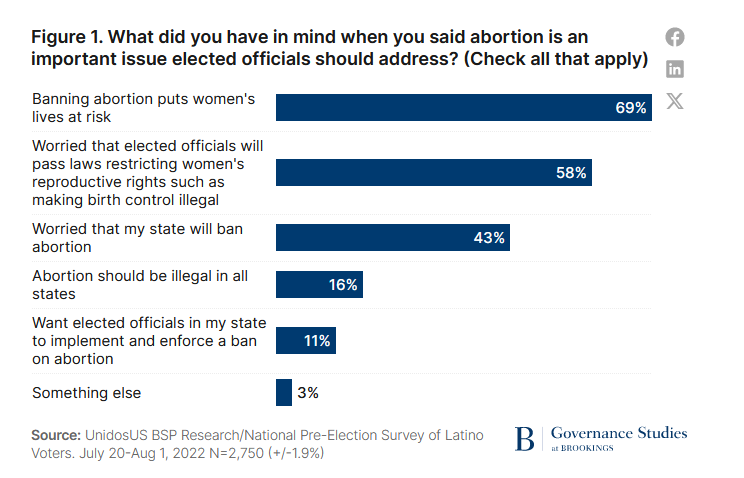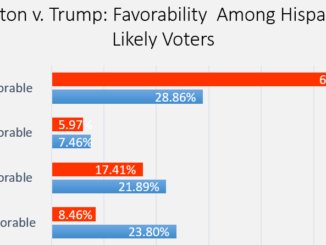
National samples are not designed to capture variation within sub-samples of the larger electorate, including Latino voters. Consequently, many national polls either suffer from a low sample size of Latino voters and/or a sub-sample of Latinos that is not designed to be nationally representative of that population.
By Gabriel R. Sanchez and Jordin Tafoy, Brookings
Relying on national samples with very limited representation of Latino respondents, an array of national news stories have projected former President Trump to capture a larger share of the Latino vote than he did in his 2020 loss to President Biden. In this post, we point out some of the limitations associated with national polls that make projections for Latino voting behavior to help illustrate how polls can lead to inaccurate inferences. We also take a look back at the 2022 election to highlight how assumptions made about Latino voters regarding abortion led to inaccurate predictions that Latinos would help the GOP win big across congressional races, noting that we are in danger of doing the same thing now in 2024.
The 2022 election season was full of pundits and supposed political experts coalescing around the notion that Republicans would ride a red wave to effective control of the House. That wave never materialized, due in part to Latinos supporting Democratic congressional candidates by a two-to-one margin. Given this result, it is surprising to Latino political scholars that a similar narrative is being repeated now in the run up to the 2024 presidential election. This is worrisome, given that this issue is not new. In fact, one of the co-authors of this article (Gabriel R. Sanchez) has been part of a wider community of scholars in Latino politics who have been critical of the National Exit Poll going back to the 2016 election. The basis of our criticism was that this widely cited survey was not designed to provide large and representative samples of Latinos.
Here is the crux of our critique.
1. National election polls are not designed for sub-group analysis.
It is important to take a step back and remind ourselves what the goal is for most polls this early in the election season. Most national polls are designed to provide a snapshot of the full electorate’s attitudes, voting preferences, policy priorities, and enthusiasm levels at this stage in the campaign season. Reputable polls do a good job of meeting this goal.
However, these national samples are not designed to capture variation within sub-samples of the larger electorate, including Latino voters. Consequently, many national polls either suffer from a low sample size of Latino voters and/or a sub-sample of Latinos that is not designed to be nationally representative of that population. Take for example the CNBC All-America Economic Survey from December of 2023 that found Trump had a five-point lead with Latino voters against Biden in a head-to-head question design. While the poll has a respectable overall sample size of 1,002 Americans, when you look at the full results of the survey, you find that only 14% of the sample are Latino (common among national samples), which is roughly 140 Latino respondents. Although the overall margin of error is small for this poll’s overall sample (+/- 3.1%), the margin of error approaches +/- 10% when referencing the Latino data. This means that the five percent lead for Trump could actually be a five percent lead for Biden or a 15% Trump advantage.
This is far from unique to this poll, as a poll from CNN, which also predicted Trump to be in the lead, includes a sample size of less than 125 for the Latino sub-sample. A poll by The Economist only has a sub-sample size of 174 Latinos, and a poll by FAU only had 69 Latino respondents in their overall sample. These small sub-sample sizes lead to significant inaccuracies in assessing the true preferences and opinions of the Latino electorate.
2. National election polls do not poll in Spanish.
Another clear limitation of many surveys not specifically designed for the Latino community is whether the survey was available in Spanish (or other languages depending on the community you are interested in). It is easier and less expensive to conduct polls only in English, so many national polls do not provide Spanish-speaking Latinos with the option to take the survey in their native language. However, we know from prior elections that language is a demographic factor that influences Latino political behavior, with Spanish-speaking Latinos being 15% less likely to have voted for Trump in the 2016 election, so systemically excluding them from national samples can generate biased inferences.1 Not surprisingly, few new national election surveys conducted this cycle have had Spanish interviews.
3. Issue importance can be misleading without content.
While identifying the sample size of a poll’s Latino sub-sample and whether the poll was conducted in Spanish are easy tests to conduct when evaluating the potential accuracy of a poll, other factors associated with polling can be much more complex. This includes measuring issue priorities from polls and making inferences based on the issues identified as important to Latinos and other sub-groups of the electorate.
In 2022, the best example of this was the salience of abortion and reproductive health to Latino voters. As one of our co-authors (Sanchez) has written about at Brookings, in 2022, polls showed that abortion was one of the top priorities for Latino voters—higher even than immigration. As abortion shot up in issue salience following the Dobbs decision, the perception among political pundits and national media was that this would benefit Republican candidates in 2022 given the widespread belief that Latinos were conversative on abortion policy.
The challenge with issue salience measures in surveys asking voters what the most important set of issue priorities are that will impact their voting behavior is that they do not provide information about the position the respondent has on the policy issue. For example, while surveys with Latino respondents were making clear that abortion was an important issue for Latino voters, most surveys did not give an indication of whether Latino voters wanted greater restrictions on abortion or wider access. Fortunately, there were surveys with large Latino samples that were representative of the Latino electorate, conducted bilingually, and full of content that could fill this void in Latino abortion attitudes.
One of these surveys asked Latino respondents who chose abortion as one of their top priorities what they “had in mind” when they said abortion was an important issue, a very valuable measure to help inform projections about the Latino vote. As reflected in the figure below, the results from this question in a national Latino survey from the summer of 2022 made clear that the overwhelming majority of these Latino voters had liberal attitudes about abortion, expressing concern that banning abortions would put women’s lives at risk or that access to reproductive health would be restricted by state and local governments. This valuable information helps explain why the Dobbs decision helped Democrats exceed expectations in 2022.

4. Let’s not repeat the same mistake in 2024.
Although it requires a little more work, we should dive deeper into survey data to provide clarity on the policy priorities of Latino voters. The Unidos US national poll conducted in late 2023 has the same question design for issue priorities as those provided in this post from their 2022 national survey, allowing for a more careful analysis of the Latino electorate. That survey therefore provides data on what Latinos have in mind for all of the top five issue priorities of Latino voters at that time.
In that poll, “inflation and the rising cost of living” was the most important issue for Latino voters, with 54% of the large national sample selecting this answer. The follow-up question reveals that most Latinos are concerned about the following: Food and basic living expenses have gone up a lot—82%; The costs of buying or renting a place to live are too high—76%; Gas prices are too high—67%. As the election approaches, it is clear that Latino voting behavior will be influenced by these pocketbook issues. The candidate that makes the case to Latinos that they can help bring down the aforementioned costs will perform well with Latino voters.
Hopefully this post helps provide some useful information for those interested in better understanding the Latino electorate as well as those who wish to be more informed consumers of polling data. As more polls become available the closer we get to Election Day, there will be more information to draw from to make projections about important sub-groups of the electorate. It is our hope that political pundits follow the suggestions we make in this post when making inferences about the Latino electorate.
.
Gabriel R. Sanchez, Ph.D., is a senior fellow in Governance Studies at Brookings. Sanchez is a professor of political science and the Founding Robert Wood Johnson Foundation Endowed Chair in Health Policy at the University of New Mexico.
Jordin Tafoya is a Ph.D. candidate in Political Science at Arizona State University.



